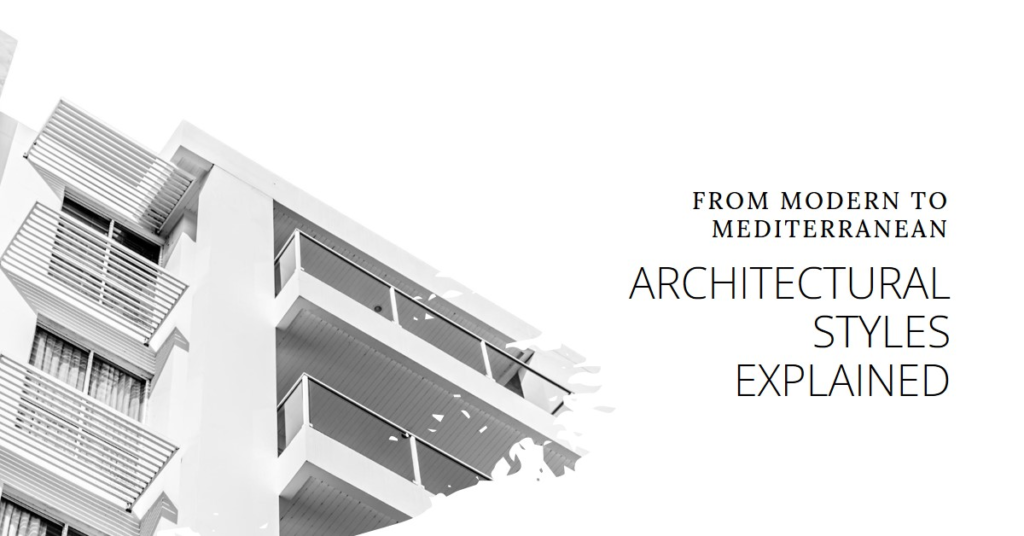
Table of Contents
Introduction to Architectural Styles
Architectural Style is the tangible expression of human civilization, reflecting cultural values, technological advancements, and aesthetic preferences. From the sleek lines of modern skyscrapers to the rustic charm of Mediterranean villas, architectural styles offer a window into the history and identity of a place. In this blog post, we will delve into the diverse world of architectural styles, examining their characteristics, influences, and unique features.
Modern Architecture:
Embracing Innovation and Functionality Modern architecture emerged in the early 20th century as a response to the industrial revolution and advancements in technology. Characterized by clean lines, geometric shapes, and minimal ornamentation, modern buildings prioritize functionality and efficiency. Architects such as Le Corbusier and Ludwig Mies van der Rohe championed the principles of “form follows function” and “less is more,” shaping the trajectory of modern design.
One of the defining features of modern architecture is the use of new materials such as steel, glass, and concrete, allowing for innovative structural designs and open floor plans. Buildings like the Guggenheim Museum in New York City, designed by Frank Lloyd Wright, exemplify the bold experimentation and avant-garde aesthetics of the modernist movement. With its spiraling ramp and organic form, the Guggenheim challenges traditional notions of museum architecture, inviting visitors into a dynamic spatial experience.


Transitional Architecture:
Bridging Past and Present Transitional architecture, also known as “neo-eclectic” or “revivalist,” draws inspiration from various historical styles while incorporating modern elements. This eclectic approach seeks to bridge the gap between tradition and innovation, honoring the past while embracing the demands of contemporary living. Transitional buildings often feature a mix of architectural elements, such as ornamental details, pitched roofs, and asymmetrical facades, creating a sense of timelessness and authenticity.
One notable example of transitional architecture is the Getty Center in Los Angeles, designed by architect Richard Meier. Situated atop a hill overlooking the city, the Getty Center combines classical elements such as columns and arches with modern materials like steel and glass. The result is a harmonious blend of old and new, where visitors can appreciate both the historical references and the cutting-edge design.
Contemporary Architecture:
Pushing Boundaries and Defying Conventions Contemporary architecture represents the ongoing evolution of design, pushing boundaries and challenging conventions. In contrast to modernism, which adheres to a set of established principles, contemporary architecture is characterized by its diversity and experimentation. Architects are free to explore new forms, materials, and technologies, resulting in a rich tapestry of styles and expressions.
One of the key trends in contemporary architecture is sustainability, with architects incorporating green building practices and renewable energy solutions into their designs. Buildings like the Bosco Verticale in Milan, designed by Stefano Boeri, demonstrate how architecture can coexist harmoniously with nature. Featuring lush vegetation on its facade, the Bosco Verticale not only provides habitat for wildlife but also improves air quality and reduces energy consumption.
Minimalist Architecture:
Embracing Simplicity and Serenity Minimalist architecture is a design approach that advocates for simplicity, restraint, and clarity of form. Rooted in the minimalist art movement of the 1960s, minimalist architecture rejects excess ornamentation and decoration in favor of clean lines and uncluttered spaces. Architects such as John Pawson and Tadao Ando are renowned for their minimalist designs, which evoke a sense of calm and serenity.
In minimalist architecture, every element serves a purpose, and unnecessary embellishments are stripped away to reveal the essential qualities of space and light. Buildings like the Church of Light in Osaka, Japan, designed by Tadao Ando, exemplify the principles of minimalism with their stark geometries and play of natural light. With its simple concrete walls and precisely positioned openings, the Church of Light creates a profound spiritual experience for visitors, emphasizing the purity and sanctity of the architectural space.
Colonial Architecture:
Tracing Historical Roots and Cultural Influences Colonial architecture reflects the legacy of European colonization in regions around the world, blending indigenous building traditions with imported styles and materials. From the grand plantation houses of the American South to the colorful colonial buildings of Latin America, colonial architecture encompasses a wide range of forms and influences.
One of the distinguishing features of colonial architecture is its adaptability to local climates and conditions, with architects incorporating strategies such as courtyard layouts, verandas, and thick walls to mitigate extreme temperatures. Buildings like the Casa de la Moneda in Potosí, Bolivia, showcase the rich heritage of colonial architecture, with its ornate facades and intricate wooden balconies. As a symbol of Spanish colonial power and wealth, the Casa de la Moneda stands as a testament to the enduring legacy of colonialism in the Americas.
Mediterranean Architecture:
Capturing the Essence of Sun and Sea Mediterranean architecture evokes the romance and tranquility of the Mediterranean region, with its sun-drenched landscapes, azure waters, and ancient civilizations. Influenced by Greek, Roman, and Moorish traditions, Mediterranean buildings are characterized by their whitewashed walls, red-tiled roofs, and shaded courtyards.
One of the defining features of Mediterranean architecture is its emphasis on outdoor living, with spaces such as patios, terraces, and gardens playing an integral role in the design. Buildings like the Alhambra Palace in Granada, Spain, exemplify the timeless beauty of Mediterranean architecture, with its intricate tilework, lush gardens, and tranquil fountains. As a UNESCO World Heritage site, the Alhambra Palace continues to inspire architects and designers with its blend of Islamic and Christian influences, creating a sense of harmony and serenity amidst the bustling city.
Conclusion:
From the sleek lines of modern skyscrapers to the rustic charm of Mediterranean villas, architectural styles offer a kaleidoscope of forms, influences, and expressions. Whether celebrating the innovative spirit of modernism or honoring the timeless traditions of the past, architecture shapes the way we live, work, and experience the world around us. By understanding the diverse array of architectural styles, we gain a deeper appreciation for the rich tapestry of human creativity and ingenuity that defines our built environment.


